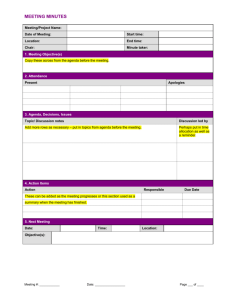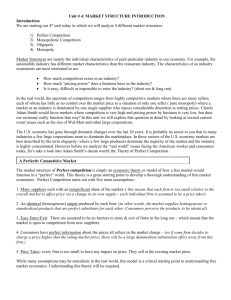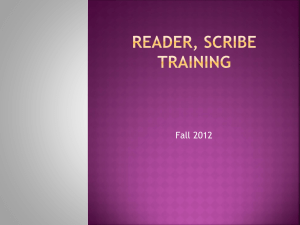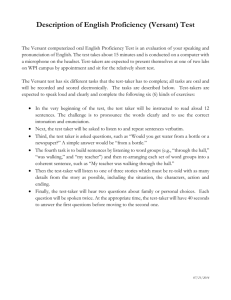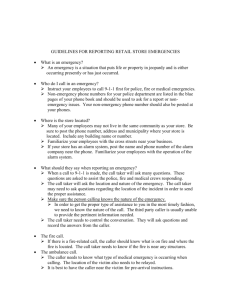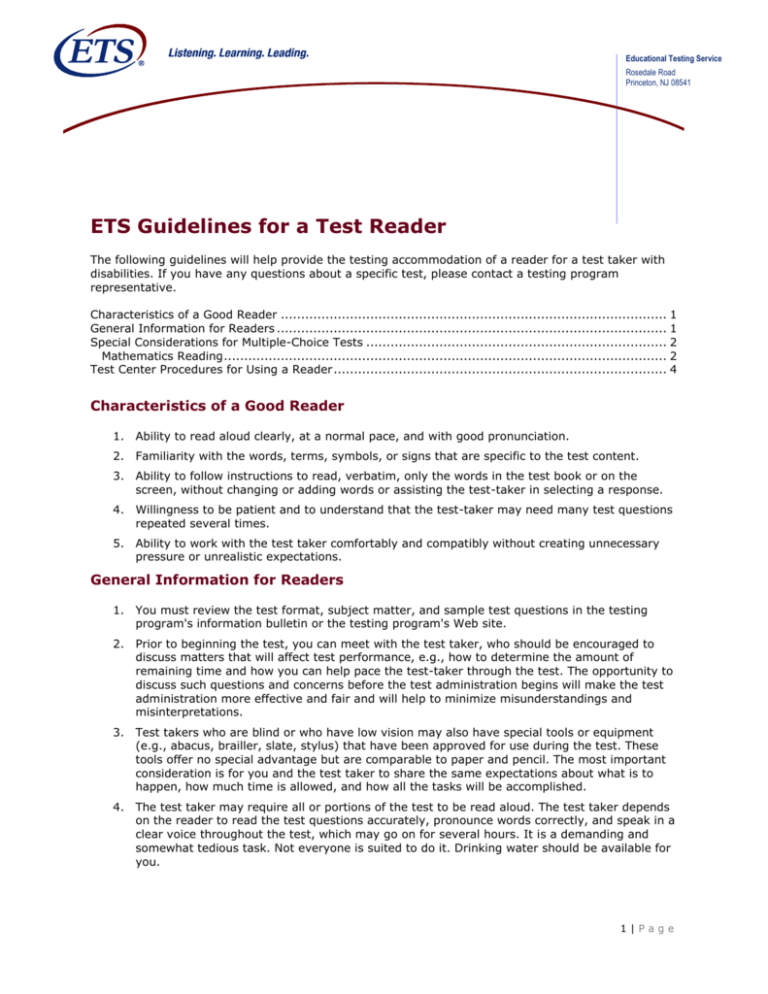
Educational Testing Service
Rosedale Road
Princeton, NJ 08541
ETS Guidelines for a Test Reader
The following guidelines will help provide the testing accommodation of a reader for a test taker with
disabilities. If you have any questions about a specific test, please contact a testing program
representative.
Characteristics of a Good Reader ............................................................................................... 1
General Information for Readers ................................................................................................ 1
Special Considerations for Multiple-Choice Tests .......................................................................... 2
Mathematics Reading ............................................................................................................. 2
Test Center Procedures for Using a Reader .................................................................................. 4
Characteristics of a Good Reader
1. Ability to read aloud clearly, at a normal pace, and with good pronunciation.
2. Familiarity with the words, terms, symbols, or signs that are specific to the test content.
3. Ability to follow instructions to read, verbatim, only the words in the test book or on the
screen, without changing or adding words or assisting the test-taker in selecting a response.
4. Willingness to be patient and to understand that the test-taker may need many test questions
repeated several times.
5. Ability to work with the test taker comfortably and compatibly without creating unnecessary
pressure or unrealistic expectations.
General Information for Readers
1. You must review the test format, subject matter, and sample test questions in the testing
program's information bulletin or the testing program's Web site.
2. Prior to beginning the test, you can meet with the test taker, who should be encouraged to
discuss matters that will affect test performance, e.g., how to determine the amount of
remaining time and how you can help pace the test-taker through the test. The opportunity to
discuss such questions and concerns before the test administration begins will make the test
administration more effective and fair and will help to minimize misunderstandings and
misinterpretations.
3. Test takers who are blind or who have low vision may also have special tools or equipment
(e.g., abacus, brailler, slate, stylus) that have been approved for use during the test. These
tools offer no special advantage but are comparable to paper and pencil. The most important
consideration is for you and the test taker to share the same expectations about what is to
happen, how much time is allowed, and how all the tasks will be accomplished.
4. The test taker may require all or portions of the test to be read aloud. The test taker depends
on the reader to read the test questions accurately, pronounce words correctly, and speak in a
clear voice throughout the test, which may go on for several hours. It is a demanding and
somewhat tedious task. Not everyone is suited to do it. Drinking water should be available for
you.
1|Page
5. Your task is to read only the test questions. Do not try to solve problems or determine the
correct answer as you read because this may result in an unconscious pause or change in
inflection that could be misleading or disconcerting to the test taker. The expression on your
face should remain neutral. Do not look at the test-taker or smile or frown to indicate approval
or disapproval.
6. Read each question as clearly as possible. Give special emphasis to words printed in boldface,
italics, or capitals, and tell the test taker that the words are printed that way. Do not give your
own emphasis to words not emphasized in print.
7. If you find an unfamiliar word or one that you are not sure how to pronounce, advise the test
taker of your uncertainty about the word and spell it.
8. When reading a word that is pronounced like another word with a different spelling, if there
can be any doubt about which word is intended, spell the word after you have pronounced it.
9. Spell any words requested by the test taker.
10. Avoid getting into conversation about the test questions, but try to respond to the test taker's
questions by repeating the item, words, or instructions as needed.
11. When reading passages, pay attention to all punctuation marks. Read the passage through
once so that the test taker can grasp the content of the passage. Some test-takers may ask
for the passage to be read through a second time with punctuation marks indicated. When
required or asked to read, with punctuation, specific lines within a passage, indicate all
punctuation found within those lines.
12. When test questions refer to particular lines of a passage, reread the lines before reading the
question and answer choices. For example, you might say, 'Question X refers to the following
lines ...' Reading the lines referred to would then be followed by reading question X and its
response options.
Special Considerations for Multiple-Choice Tests
1. Be particularly careful to equally stress each response option and read all of them before
waiting for a response. The test taker will record the answer or provide the answer to the test
administrator (writer), who will record it for the test taker.
2. If you are recording answers and if the test-taker designates a response choice by letter only
("D," for example), ask if you should reread the complete response before the answer is
recorded.
3. If the test taker chooses an answer before you have read all the answer choices, ask if you
should read the other response options.
4. Allow the test taker to pause before responding. However, if the test taker pauses for a
considerable time following your reading of the answer choices, say: "Do you want me to read
the question again ... or any part of it?" In rereading questions, be careful to avoid any special
emphasis on words not emphasized in the printed copy by italics or capitals.
Mathematics Reading
A test taker is permitted to ask the reader to write notes and to assist with intermediate steps in
computing mathematics problems, especially if the test taker has no tools or equipment for taking
notes or is unable to do so. For example, in the multiplication of numbers (e.g., 17 x 521), a test
taker may say, "Seven times one is seven. Put down the seven. Seven twos are fourteen. Put down
the four to the left of the seven and carry the one." The test taker should be specific in directions to
the reader as to what he or she writes, in which column to write it, what to carry, etc.
Mathematical expressions must be read precisely and with care to avoid misrepresentation for a
test taker who has no visual reference. For math items involving algebraic expressions or other
mathematical notation, it may be preferable for the reader to silently read the entire question before
2|Page
reading it aloud to the test-taker. Use technically-correct yet simple terms, and be consistent in the
treatment of similar expressions. Some typical expressions and the manner in which they should be
read follow:
(a) Lowercase letters that are juxtaposed should be read as a multiplication expression: e.g.,
xy should be read as "x y," unless it is part of a complex expression or this reading is
otherwise unclear, in which case read it as "x times y."
(b) Capital and lower-case letters should be differentiated because they can have different
meanings in mathematical or scientific expressions.
e.g. R - 2y = 6 should be read as "Capital R minus two y equals six."
(c) Simple numerical fractions should be read as fractions: e.g.,
should be read as "five sixths."
However, similar letter expressions can be read as one letter "over" another: e.g.,
should be read as "a over b."
(d) To prevent confusion, complicated fractions (those that contain other mathematical
operations) should be read in terms of their numerators and denominators: e.g.,
should be read as "a fraction with numerator b plus d and denominator c."
If there is any question as to where the fraction ends, say "end fraction."
(e) Negative numbers should be read as "negative."
e.g., -5 should be read as "negative five," not "minus five."
When a subtraction operation is involved, read the sign as "minus," e.g.:
x - 5 should be read as "x minus five."
(f) Expressions containing multiple mathematical operations should be read exactly as they
appear. Expressions containing parentheses or brackets can be read in any of the following
three ways:
quantity, close quantity
paren, close paren (or bracket, close bracket)
left paren, right paren (or left bracket, right bracket)
For "paren, close paren" or "left paren, right paren," it is also acceptable to use "parenthesis"
instead of "paren." If you use the term "quantity," in complicated expressions, announce
where enclosed portions end by saying "end quantity."
3|Page
E.g., (2x - 6y) - 10 could be read
as "The quantity two x minus six y, close quantity, minus ten;"
as "paren, two x minus six y, close paren, minus ten;"
or as "left paren, two x minus six y, right paren, minus ten."
a (x - y) could be read as "a, parenthesis, x minus y, close parenthesis."
a × b2 could be read as "a times the square of b."
Use pauses to audibly group sections of an expression together.
z + (-a) could be read as "z plus [PAUSE] paren negative a close paren."
(g) If equations are used in the test you will be reading:
Since equations are a shorthand means of stating relationships between quantities, the
reader's job is to translate this shorthand back into everyday English. Read equations in this
order:
If the equation is numbered, read its number first.
Give the meaning of each letter or symbol.
Read the equation.
e.g.:
E = mc2E = energy in ergs
m = mass in grams
Eq. 6-2
c = speed of light in cm./sec.
Read as "Equation six dash two. Capital E equals energy in ergs, m equals mass in grams, and c
equals the speed of light in centimeters per second. Then, Capital E equals m c squared."
Test Center Procedures for Using a Reader
An approved reader should be admitted to the test center with the test taker. The reader's photobearing identification should be checked.
Prior to the start of the exam, the test center administrator/supervisor will review the Guidelines with
the test taker and the reader and will set the ground rules for the conduct of the examination.
The test administrator must remain in attendance at all times during the test administration.
An approved reader is not present to function as an aide to the test center staff. It is inappropriate to
ask the reader to perform clerical duties of any kind. The reader should not be asked to assume any
responsibilities belonging to either the center staff or the test taker.
4|Page
Test center staff must ensure that proper test security is maintained at all times. It is important that
the test administrator ask questions and avoid any hasty interpretations of what may be
communication of test content or exchange of information between the test taker and the reader that
might give the test taker an unfair advantage. The task requested by the test taker might be
acceptable once understood. Discussion or communication concerning interpretation of test content is
not permitted. If such discussion occurs and cannot be controlled, or if test center staff observe
anything they deem unusual, the situation should be reported on the Supervisor's Irregularity Report
(SIR) or the Electronic Irregularity Report (EIR) and the test taker advised of this action.
The test center administrator may also stop the test and dismiss the test taker if he or she believes
that the reader has provided the test taker with any unfair advantage. In such instances, ETS reserves
the right to cancel the test taker's score.
Copyright © 2002 by Educational Testing Service. All rights reserved.
The ETS logo is a registered trademark of Educational Testing Service.
5|Page

